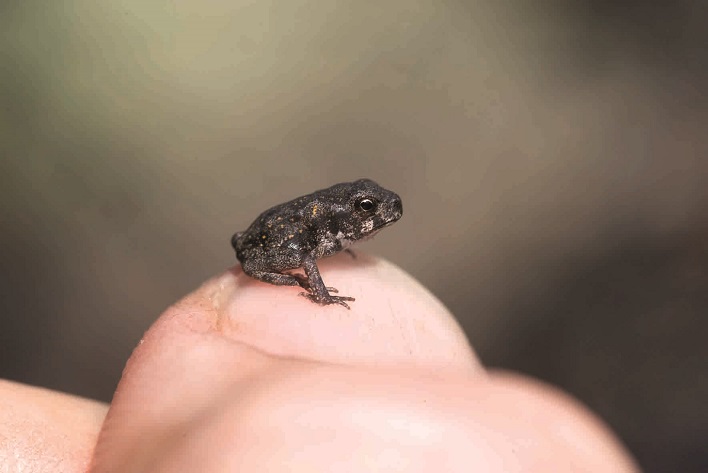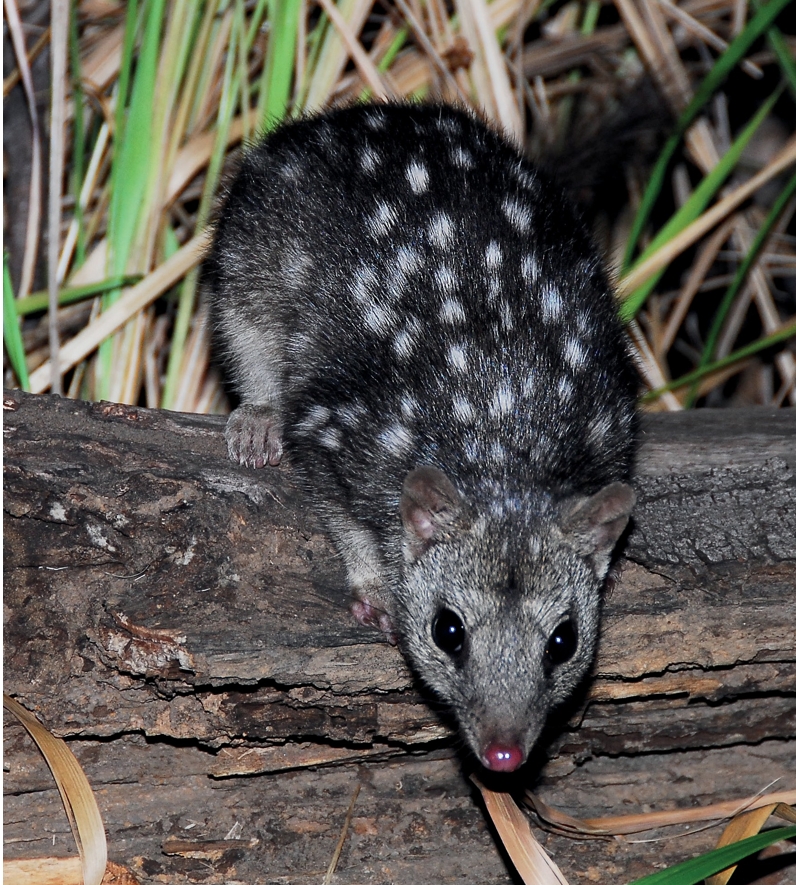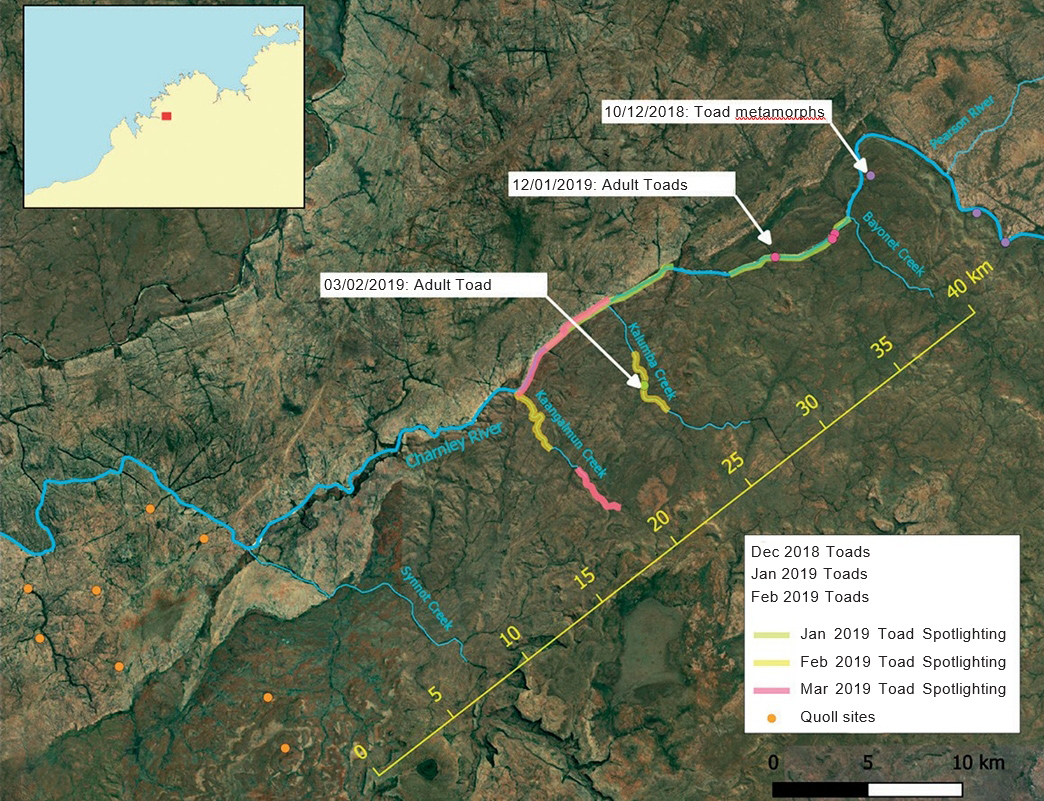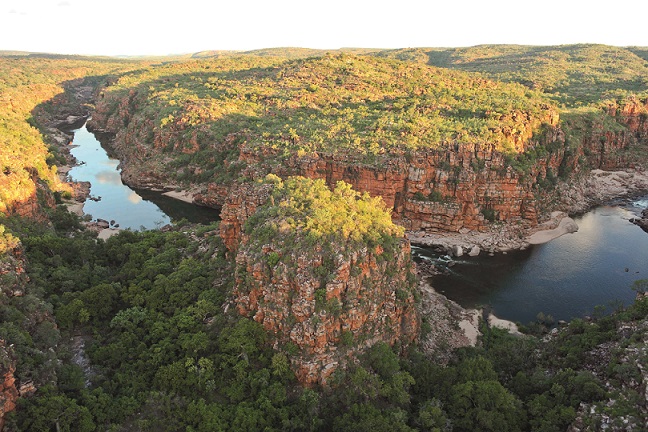By Dr Rohan Wilson, Wildlife Ecologist, Dr John Kanowski, Chief Science Officer, and Dr Alexandra James, former AWC Senior Wildlife Ecologist
As cane toads continue to invade northern Australia, AWC ecologists in the Kimberley have been testing innovative techniques to mitigate their impact on native predators, with a particular focus on protecting endangered Northern Quolls.
Once common across northern Australia, quolls have declined due to predation by feral cats, wildfire and other factors. Cane toads pose an additional serious threat to quolls, as they carry a toxin that is novel to most Australian animals. Many populations of quolls and other native predators have collapsed across northern Australia as toads have invaded.
 © David Nelson/AWC
© David Nelson/AWC
Cane toads first arrived at AWC’s Mornington Wildlife Sanctuary in the Kimberley in the 2016-17 wet season. Toads are expected to invade the Artesian Range in 2019-20.
Why do some quolls persist in the presence of cane toads?
Encouragingly, some quoll populations have managed to survive ‘behind enemy lines’ in Queensland despite toads being present for decades. Two theories have been proposed for the persistence of these quolls.
The first theory is conditioned taste aversion (CTA), whereby animals learn though experience that toads are poisonous by ingesting a sub-lethal amount of toad toxin. This could occur in the wild when predators eat a small toad before they encounter an adult, ingesting enough toxin to make them sick but not kill them, hence developing an aversion to toads. Juvenile quolls may also learn to avoid toads from their mothers.
 © Wayne Lawler/AWC
© Wayne Lawler/AWC
The second theory proposes a genetic basis for not eating toads in some individuals. Once toads arrive in an area, individuals with this trait are favoured to survive and reproduce, such that this trait becomes dominant in the population. Innovative approach required as cane toads arrive in the Kimberley.
Conducting experimental research on a landscape scale
At present, we do not know which theory is correct. However, faced with the potential collapse of quoll populations in the Kimberley, AWC has been conducting innovative – and highly experimental – research aimed at protecting wild populations of quolls, in collaboration with academics from the University of Technology Sydney and University of Melbourne. The research, predicated on the CTA theory, involved deploying sausages made from toad meat laced with a nausea-inducing chemical to try to teach quolls to avoid eating toads. This was the first time CTA theory had been rigorously tested on a wild population of quolls.

PhD student Naomi Indigo, assisted by AWC ecologists, tested the efficacy of toad sausages in inducing CTA in quoll populations. The project required quantifying the size of each population, the number of individuals that attempted to eat toad sausages, and importantly, the proportion that came back for a ‘second bite of the sausage’. The results showed, on average, 60 per cent of quolls in a population ate toad sausages. Of these, between 40 and 70 per cent did not attempt to consume baits a second time. Taken together, these data suggest toad sausages induced CTA in 24 to 42 per cent of quolls in a population.
Based on these results, we deployed toad sausages at Mornington in the 2016-17 wet season, as toads entered the sanctuary. Camera traps were used to quantify quoll population sizes at treatment sites, before and after toads invaded, as well as at control sites, where quolls were present but sausages were not deployed. This design (replicated Before-After-Treatment-Control) allowed us to robustly determine any effect of the treatment.
The result: toad sausages failed to protect quolls on Mornington. Regardless of treatment, quoll populations crashed soon after toads arrived. Nevertheless, a small number of quolls have persisted.
Identifying knowledge gaps
This project highlights the challenges involved in finding landscape-scale solutions to key threats to wildlife like cane toads. However, science progresses by testing hypotheses. The results have helped AWC’s scientists identify important questions we need to address in any future toad sausage deployments, including:
1. Will quolls ‘trained’ on toad sausages avoid eating live, hopping toads?
2. Are toad sausages, as currently formulated, sufficiently attractive or ‘educational’ to quolls?
3. How frequently do we need to deploy baits ahead of toads invading an area?
Refining our forward strategy
These lessons are informing our forward strategy as we focus on protecting quolls in the Artesian Range. First, we plan to track multiple populations of quolls as toads invade the area. Some populations may survive without active intervention, either because sufficient numbers of quolls encounter small toads before adults, or because of inherent avoidance of toads among quolls in those populations.
 © Wayne Lawler/AWC
© Wayne Lawler/AWC
Second, we will intensively monitor quoll populations around the David Attenborough Field Research Station in the Artesian Range. It is one of very few sites where we can follow the fate of a well-studied quoll population in detail and in real time as toads invade.
For a subset of quolls, we aim to test the efficacy of CTA, deploying toad legs (rather than sausages) at two to three-month intervals during the invasion phase. We will follow the fate of these animals using live trapping. We will also collect tissue samples to determine whether the survival of quolls has a genetic basis.
Preparing for the next assault
In preparation, teams of AWC ecologists have been surveying quoll populations in the Artesian Range and closely monitoring the cane toad front, currently on Charnley River, to inform the timing of the aversion training. The intensive study of quolls around the David Attenborough Field Research Centre will commence at the start of the 2019-20 wet season, with CTA trials to follow ahead of the toad invasion.
This project highlights the challenges involved in finding landscape-scale solutions to key threats to wildlife, like cane toads. The results of this important research will inform future strategies to protect quoll populations that are yet to be invaded by cane toads, like those on Yampi and elsewhere in the Kimberley.